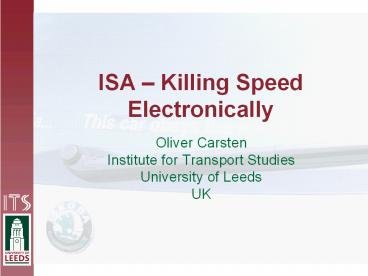ISA - PowerPoint PPT Presentation
1 / 18
Title:
ISA
Description:
Title: Slide 1 Created Date: 2/16/2006 10:27:10 AM Document presentation format: On-screen Show Company: ITS Other titles: Arial Times New Roman Wingdings V&W Syntax ... – PowerPoint PPT presentation
Number of Views:131
Avg rating:3.0/5.0
Title: ISA
1
ISA Killing Speed Electronically
- Oliver Carsten
- Institute for Transport Studies
- University of Leeds
- UK
2
How does ISA operate?
Evidence from trial after trial is that this can
be made to work reliably
- Position a GPS-based navigation system
- Information a digital road map with speed limits
3
Driving with ISA reduces crash risk
- Calculation of individual crash risk with
intervening ISA (report to Transport for London,
2006) - Method
- By combining observed changes in speed behaviour
on 30 mph roads (from ISA-UK Trial 1) - With risk of crash involvement given driving
speed on urban roads (from Kloeden et al., 1997) - We can calculate an average saving in the risk of
a crash - Answer
- 19.3 reduction
4
Attitudes
- Generally supportive public attitudes
- MORI poll in UK for FIA Foundation in 2002
- 70 support for warning ISA in urban areas
- 58 would support non-overridable limiters on
residential streets if that meant road humps
would be removed - ISA grows on those who experience it
- Almqvist and Nygard (1997) found that 73 of
drivers reported being more positive towards ISA
after using it than before - Lahrmann, Madsen and Boroch (2001) reported that
15 out of 20 drivers became more favourable to
using ISA after experience of the system
5
ISA brings other benefits
- Fuel savings
- CO2 savings
- Potential to reduce journey time (managed
motorways reduction in incidents) - Cheap traffic calming
6
PROSPER ResultsBenefits and Costs
- Oliver Carsten
- Institute for Transport Studies
- University of Leeds
- UK
The Prosper project is co-funded by the European
Commission, Directorate General for Energy and
Transport.
7
Accident prediction and cost-benefit analysis
- Six countries Belgium, Great Britain, France,
NL, Spain and Sweden - Two major scenarios
- Market driven (those who want ISA fit it)
- Authority driven (first encouragement and then
compulsion) - Scenarios affect mix of ISA systems
- Procedure
- Predict traffic growth
- Predict accident risk without ISA
- Predict additional safety impact of ISA (via
change in speed patterns) - Analyse costs and benefits
8
Penetration of Voluntary ISA in Market-Driven
Scenario
9
Penetration of Voluntary ISA in Authority-Driven
Scenario
10
Reductions in fatalities (ISA versus no ISA) in
2050
11
Benefit-to-cost ratios by country and scenario
Note Year of mandatory usage for Authority
Scenario is in range 2032 to 2035
12
Implementation of ISA
- Comments at PROSPER seminar (policy-driven
group) - Waiting till 2035 or 2050 is too long
- Can we learn some lessons from another successful
technology seatbelts?
13
Time line for seatbelts
1949 Nash offers lap belts in USA
1950 Nash withdraws option
1955 Ford and Chrysler offer optional lap belts in USA
1959 Volvo introduces 3-point belt as standard in Sweden
1962 Seatbelt anchors standard in US
1967 GB requires installation of 3 point belts in front
1968 US requires installation of 3 point belts in front
1968 GB requires retrofit of 3 point belts in front on model year 1965 and later cars
1970 Victoria (Australia) mandates use in front and rear
1975 Sweden mandates use in front
1983 GB mandates use in front
14
Stages
- Stage 1 Voluntary fitment
- Lots of trouble to install
- Stage 2 Required anchorages
- Pioneers adopt
- Stage 3 Required fitment
- Large numbers can voluntarily adopt
- Stage 4 Compulsory usage
15
The Tipping Points
- The Tipping Points are
- Requiring capability on the vehicle ( the
seatbelt anchorages)This enables voluntary
fitment - Requiring fitmentThis enables large-scale
voluntary usage
But also one crucial difference with
seatbelts ISA cannot be used without an
information service
16
Great Britain Seatbelt wearing rates for front
occupants of cars and vans
17
Conclusions
- ETSC seeks to identify and promote effective
measures on the basis of international scientific
research and best practice in areas which offer
the greatest potential for a reduction in
transport crashes and casualties. - ISA fits those criteria with huge potential for
casualty reduction - ETSC and other safety organisations should
promote 2 stages of deployment - Stage 1
- A pan-European speed limit information service
- A standard link between speed limit information
and vehicle control (ECE Reg 89 on Speed
Limitation Devices as amended in 2002 allows for
adjustable speed limiters) - Stage 2
- Required fitment of intervening (but overridable)
ISA
18
One last point
- Do we need a new name for ISA?
- How likely is that a customer will walk into the
showroom and ask for Intelligent Speed
Adaptation? - How about In-Vehicle Speed Support (IVSS)?































